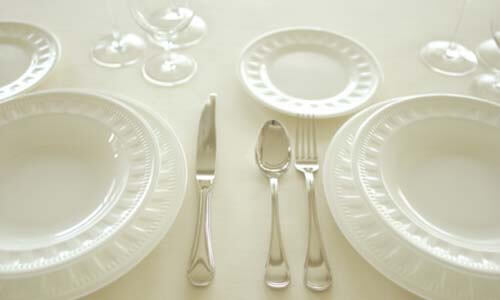Making Coffee
A superior cup of coffee is made of freshly ground coffee beans roasted within a week of transit, packaging, and shipping; cold, fresh water; and a clean coffee maker.
cold, fresh water
Cold, fresh water accounts for a great deal of the flavor of coffee. Because cold water contains more oxygen than hot water, to ensure freshness let the tap run for a few moments or use cold bottled water. When water is brought to a boil, it loses oxygen and produces coffee with a flat flavor. The best flavor is obtained from cold tap water brought to a simmer (approximately 200°F, or 93°C), slightly less hot than boiled water (212°F, or 100°C) and hotter than "instantly-hot" water drawn from a valve (190°F, or 88°C).
Hot tap water lies in a hot-water tank for indefinite periods of time and may acquire impurities from the pipes that bring out the tannic acid in coffee and promote a brew with a bitter taste. Because hard tap water contains alkalines that neutralize the taste of the flavor-giving acids, and artificially softened water is treated with chemicals that promote a flat flavor, use filtered water to brew a superlative cup of coffee.
To make instant coffee, lift the kettle from the burner after the water has reached a simmer. Before pouring water over the grounds, hold the kettle for a second or two to lower the temperature.
clean coffeepot
A clean coffeepot is one that is free of coffee oils that cling to the interior surface like an invisible shield and promote brew with a bitter taste. To cut the oils, disassemble a coffee maker and wash the parts in hot, soapy water. Use a nonabrasive sponge on the interior of the pot, one that will not leave scratches and grooves where oils and minerals may collect. Or soak the parts in 1 to 2 teaspoons of baking soda dissolved in hot water. Cut the buildup of lime deposits with a solution of vinegar and water.
Here are some general tips for making a choice cup of coffee.
Use a glass or ceramic coffee maker: Metal does not enhance the flavor of coffee. But if you must brew in a metal pot, stainless steel is best, followed by nickel, copper, aluminum, and tin in descending order of taste.
Do not let coffee stand. Oxidation robs coffee of flavor, and when the brew is left to stand it develops a bitter taste. For maximum flavor, drink coffee soon after it is made and make a fresh pot as needed. Although coffee begins to stale approximately 15 minutes after it is brewed, electric coffee makers keep coffee fresh for about an hour at temperatures of approximately 185 to 190°F (85°C to 88°C).
Make a full pot of coffee. Because oxidation degrades the flavor of coffee, always brew the maximum amount a pot is made to hold. Brew eight cups of coffee in an 8-cup coffee maker, even though four cups are used, and preserve the remainder in a thermal carafe.
Never reheat leftover coffee. Stale coffee has fewer soluble substances than fresh coffee, and the flavor is bitter.
Don't make "weak coffee." Instead, prepare it full strength and dilute the taste with hot water, cream, or milk.
ratio of ground coffee to water
A first-rate cup of coffee means different things to different people. Some people like coffee with a strong taste and others prefer a mild flavor. The approved coffee measure (ACM) is 2 level tablespoons of ground coffee to every 5-ounce cup of water, although 6 ounces are often used. The key word here is level tablespoons compared to rounded or heaping. Because ground coffee retains water, coffee brewed to ACM measurements yields less than the measured amount, or approximately threequarters of a cup of coffee. Less coffee is used to make instant coffee. Mugs hold approximately 8 to 12 ounces of water, and the measurement is adjusted upward accordingly.
The following ratio of ground coffee to water is for one 5-ounce cup of coffee, a guideline that can be adjusted to personal preference.
Instant coffee: 1 teaspoon of coffee, rounded or heaping, to 5 ounces of water
Moderate-strength coffee: 2 level tablespoons of coffee to 5 ounces of water
Strong coffee: 2 rounded tablespoons of coffee to 5 ounces of water, plus an extra spoonful "for the pot"
After-dinner coffee: 4 tablespoons of coffee to 2 ½ ounces of water
Turkish coffee: 1 to 2 tablespoons of Turkish coffee to 1 ½ to 4 ounces of water
coffee brewing time
The brew time for each grind is different. In general, the finer the grind, the more surface area is exposed to water and the faster the essential oils are extracted.



